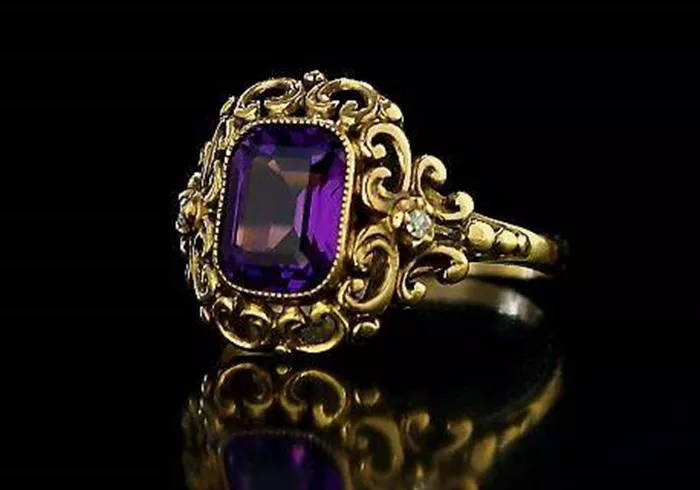Amethyst, a stunning purple variety of quartz, has long captivated people with its vibrant hue and rich history. As engagement rings continue to evolve from traditional diamonds to unique and personal choices, amethyst has emerged as a compelling option. This article explores whether amethyst is a good choice for an engagement ring by examining its qualities, benefits, and considerations. We will also cover the best ways to care for an amethyst engagement ring and provide guidance on how to make it a perfect symbol of your commitment.
The Allure of Amethyst: An Introduction
Amethyst is renowned for its deep purple tones, which can range from light lavender to dark violet. Its color is attributed to trace amounts of iron and other elements within the quartz. The stone has been valued throughout history for its beauty and alleged metaphysical properties, making it a popular choice in various types of jewelry.
The Symbolism and History of Amethyst
Amethyst has been admired since antiquity. The ancient Greeks believed it had protective properties and could prevent drunkenness. In Christianity, it symbolizes piety and humility, often worn by bishops. This rich symbolism adds an extra layer of meaning to amethyst, making it a sentimental choice for engagement rings.
Why Choose Amethyst for an Engagement Ring?
Unique Beauty
Amethyst’s captivating purple color sets it apart from more traditional gemstones. This uniqueness allows for a distinct and personal touch, especially for those looking to break away from conventional diamond engagement rings. The stone’s versatility means it can be set in various styles, from classic solitaires to intricate vintage designs.
Affordability
Compared to diamonds, amethyst is significantly more affordable. This cost-effectiveness allows for larger stones or more elaborate settings within a similar budget. It also provides the opportunity to invest in additional details or complementary pieces of jewelry.
Durability
Amethyst ranks 7 on the Mohs scale of mineral hardness, making it relatively durable for daily wear. While not as tough as diamonds (which rank 10), amethyst can withstand the rigors of daily life if properly cared for. This durability makes it suitable for engagement rings, though it does require some precautions.
Versatility
Amethyst pairs well with various metals, including gold (yellow, white, and rose) and silver. Its color can complement both warm and cool tones, offering flexibility in design. Additionally, amethyst’s purple hue can be enhanced with complementary gemstones or intricate settings.
See also: What Does Amethyst Symbolize?
Color and Quality
The value of amethyst is influenced by its color, with deep, rich purple stones typically being more valuable. The presence of secondary hues like red or blue can also affect its appearance and value. When selecting amethyst, ensure the color is consistent and free of significant inclusions or imperfections.
Treatment and Enhancement
Many amethysts undergo heat treatment to enhance their color. While this is a common practice and generally stable, it is important to discuss any treatments with your jeweler. Understanding whether your amethyst has been treated can help you make an informed decision about its care and longevity.
Setting and Design
Choosing a setting that protects the amethyst while showcasing its beauty is crucial. Popular settings for amethyst include bezel settings, which provide extra security, and halo designs, which enhance the stone’s visual impact. Ensure that the setting complements both the amethyst and the wearer’s style.
Care and Maintenance
Amethyst requires careful handling to maintain its beauty. It is relatively resistant to scratches but can be affected by prolonged exposure to sunlight and harsh chemicals. Regular cleaning with mild soap and water, combined with occasional professional checks, will help preserve the stone’s clarity and vibrancy.
Best Practices for Caring for an Amethyst Engagement Ring
Regular Cleaning
Clean your amethyst ring with a soft cloth and mild soap solution. Avoid using ultrasonic cleaners or harsh chemicals that could damage the stone. Gently brushing the ring with a soft brush can help remove any accumulated dirt.
Safe Storage
When not in use, store your amethyst ring in a soft pouch or jewelry box to prevent scratches and damage. Keeping the ring separate from other jewelry pieces can help protect it from abrasion.
Avoiding Harsh Conditions
Remove your amethyst ring before engaging in activities that could expose it to harsh conditions, such as swimming or cleaning with abrasive chemicals. Prolonged exposure to sunlight or extreme temperatures can also affect the stone’s color and clarity.
Conclusion
Amethyst is an excellent choice for an engagement ring, offering a unique and affordable alternative to traditional gemstones. Its rich color, symbolic meaning, and versatility make it a standout option for those looking to express their individuality and style. By understanding its properties, selecting the right setting, and maintaining proper care, amethyst can be a lasting and beautiful symbol of your commitment.
Whether you’re drawn to its vibrant hue, its historical significance, or its affordability, amethyst provides a distinctive way to celebrate your engagement. Embrace its beauty and make it a meaningful centerpiece in your journey together.
FAQs
How does amethyst compare to diamonds in terms of durability?
Amethyst is less durable than diamonds, ranking 7 on the Mohs scale of hardness compared to diamonds’ perfect 10. While amethyst can handle daily wear, it is more prone to scratches and damage. Proper care, such as avoiding harsh chemicals and physical impact, can help maintain its condition.
Can amethyst engagement rings be customized?
Yes, amethyst engagement rings can be highly customized. Jewelers offer various settings and designs to showcase amethyst’s beauty. Options include classic solitaire settings, halo designs, and intricate vintage styles. Customization allows you to select a design that reflects personal style and enhances the amethyst’s appeal.
How does the color of amethyst affect its value?
The value of amethyst is significantly influenced by its color. Stones with deep, rich purple hues are generally more valuable. Secondary colors, such as red or blue, can affect the stone’s overall appearance and value. When purchasing an amethyst, look for stones with vibrant, consistent color and minimal inclusions.

